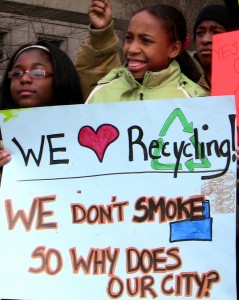Putting together the puzzle of EE funding to locate EE resources in cities.

A 1998 paper described EE as a process “in which diverse providers offer pieces of a puzzle.” Different pieces are funded by different sources. Photo courtesy of Clear Matters.
Urban environmental education can increase student motivation, develop citizenship, and provide nature exposure to students who are disconnected with their environments. But how can urban environmental education be funded?
A 1998 paper for the North American Association for Environmental Education said, “In some ways, environmental education can be conceived of as a societal process, in which diverse providers offer pieces of a puzzle that individuals put together for themselves.”
Different pieces of the EE puzzle receive funding from different sources.
To piece together the puzzle, we’ll start on a national level.
In 1990, Congress passed the National Environmental Education Act, which required the EPA to create an Office of Environmental Education with a six-to-ten-person staff. The Office developed EE curricula, supported training for educators, distributed EE awards, and encouraged young people to enter the environmental field.
In recent years the 2009 Great Recession and the US budget crisis have sapped resources from many federal programs, and environmental programs have been hit hard.
The Obama Administration’s 2013 budget proposal made over $20 million in cuts to EE spending, including eliminating the Office of Environmental Education.
Current federal EE spending consists of $2-3 million a year in EPA grants to nonprofits, education agencies and environmental agencies. With under 100 grants awarded yearly since 2009, the grant program cannot serve as a main source of environmental education funding.
Participants at the 2012 White House Summit on Environmental Education expressed the need for Environmental Education to become a federal priority. Meanwhile, the plethora of diverse EE programming gets its funding elsewhere.
Environmental education is rapidly developing, and it is necessarily local, particularly in cities. “Community-level action is empowering in all areas–especially urban,” participants agreed in notes from the White House EE Summit.
Consequently, research about environmental programs is also necessarily local, and it is difficult draw nationally relevant conclusions.
What researchers, educators, and theorists agree on is that EE must look to all available strategies and sources of funding: educators “need to work together to share scarce resources,” White House summit participants agreed.
What are those resources? Let’s look at the other pieces of the environmental education puzzle.
In many cases, state and regional governments offer funding for EE to engage students in conserving local environmental resources.
Maryland’s Environmental Education program, for example, works to “enable students…to preserve and protect the unique natural resources of Maryland, particularly those of the Chesapeake Bay and its watershed.” The program outlines environmental literacy standards for Maryland students and provides an environmental education curriculum and toolkit for schools.
Such programs use state budgets for EE by tying EE to regional values such as preserving a state’s resources.
Another piece of the puzzle lies in nonprofits. National nonprofits like the National Audubon Society receive grants and donations for their environmental work. Audubon attracts funding with its specific brand of wildlife conservation. Committing some of this funding to EE, Audubon offers educational summer camps and provides scholarships for students who need financial assistance.
Another source of EE funding lies in reworking academic programs in schools. Some of the most effective environmental programming comes when educators integrate EE into their curricula.
Schools and teachers have to meet core requirements to keep their funding, but EE can become part of meeting those requirements. “To make environmental education an automatic part of what goes on in school, what needs to happen is more project based learning that crosses many curricula,” says social worker Abby Reifsnyder, who helped design a service-learning project in a North Adams, MA, alternative program. Her students built a path along their local river last fall.
“If you can help teachers work together on projects that cross curricula, they can cover all the things they need to cover to meet common standards, and the kids get engaged in their environment.”
When we look specifically at cities, we find more pieces to add to the EE puzzle.
Conservation efforts in cities are concentrated in limited green spaces–rivers and public parks. This means much of the funding for EE in cities comes from conservancies.
Conservancies draw funding from government programs, environmentalists, conservationists and others invested in preserving green spaces. As part of their efforts, they involve students in their local nature as interns and volunteers–a huge contribution to urban EE.

Young people in Detroit in 2010 protest an incinerator that burns most of Detroit’s waste to produce electricity. Photo courtesy of Global Alliance for Incinerator Alternatives.
Another puzzle piece unique to urban communities is the connection between EE and environmental justice movements. Poor urban communities often face a disproportionate number of waste and energy facilities because they lack the political clout that wealthier communities use to block such facilities.
Environmental justice groups are residents who join together to fight these injustices and preserve their green spaces. While local environmental justice groups aren’t federally funded and don’t have endowments, they have another resource just as valuable: passionate volunteers.
Environmental education is key to the goals of environmental justice groups, who work to educate the community about environmental injustice in order to fight it. Environmental injustice is an important aspect of EE in cities. Bronx River Alliance Chief Educator Damian Griffin says teaching environmental injustice is about “taking the environment [students] are already uncomfortable with and then putting it into perspective about why it is the way it is.”
Putting the urban EE puzzle together also means rethinking the viability of EE in urban schools.
A 2012 study worked with parents and educators in a Bronx after-school program to overcome the barriers around urban EE–from perceived lack of time to the lack of green spaces. The study used focus groups to identify barriers and developed training sessions for educators to counter them. Sessions involved giving teachers workshop-style trainings and providing time to plan for incorporating EE into their curricula.
According to the study, educators who had initially expressed a lack of time for EE said, “With all the workshops, trainings, I feel we have a lot of resources. I feel we have the help that we need.”
The study stressed that its methods would find success in other schools as well.
There is no single answer to successful EE funding. Funding urban environmental education means embracing and expanding the diversity of EE resources. While educators can continue to advocate for federal funding, a growing patchwork of other sources is providing for environmental programming.
The unique combination of EE resources in cities must be taken into account. The more widely organization can partner, share information, and pool resources, the further environmental educators can move towards widespread urban environmental education.